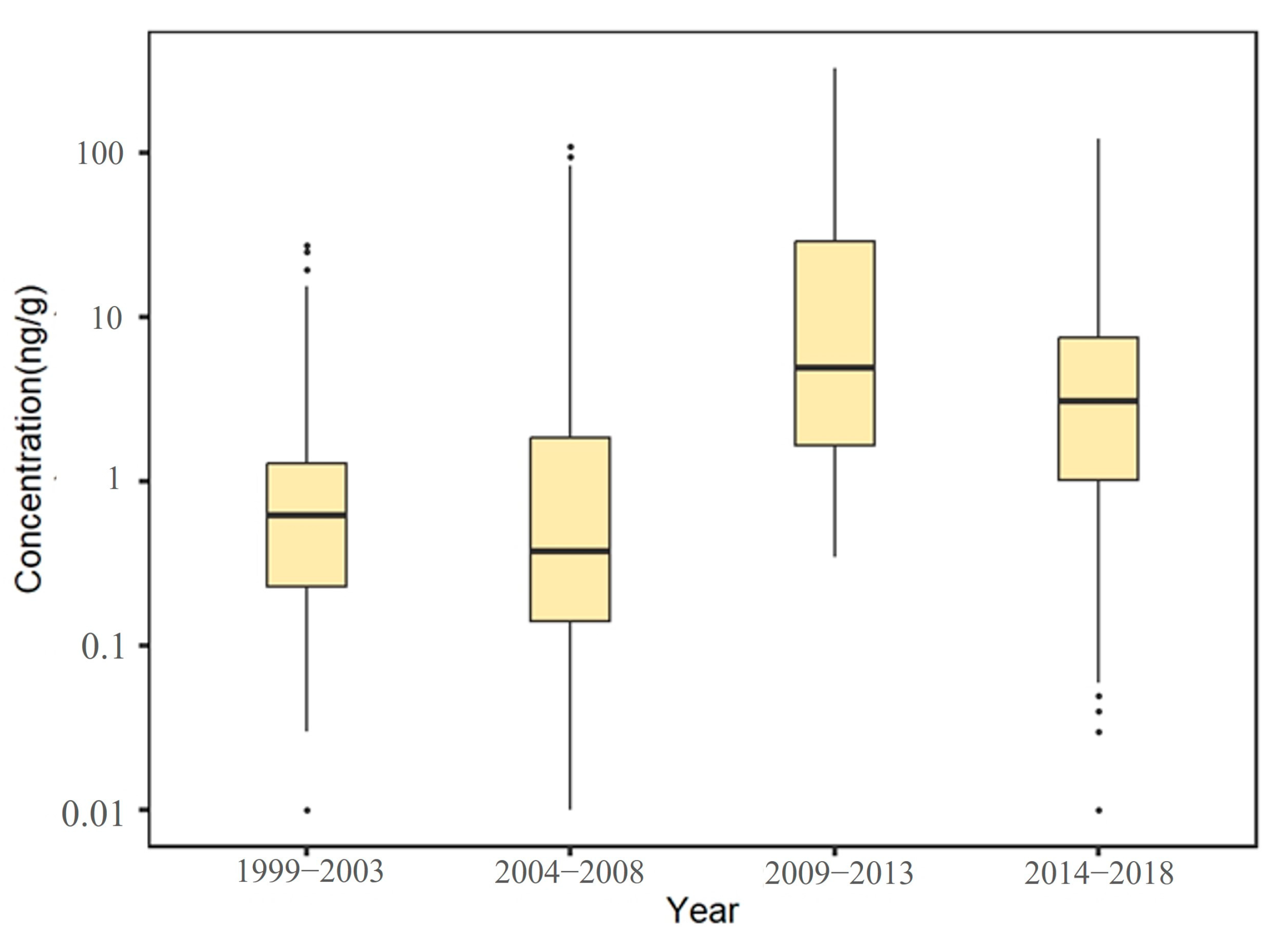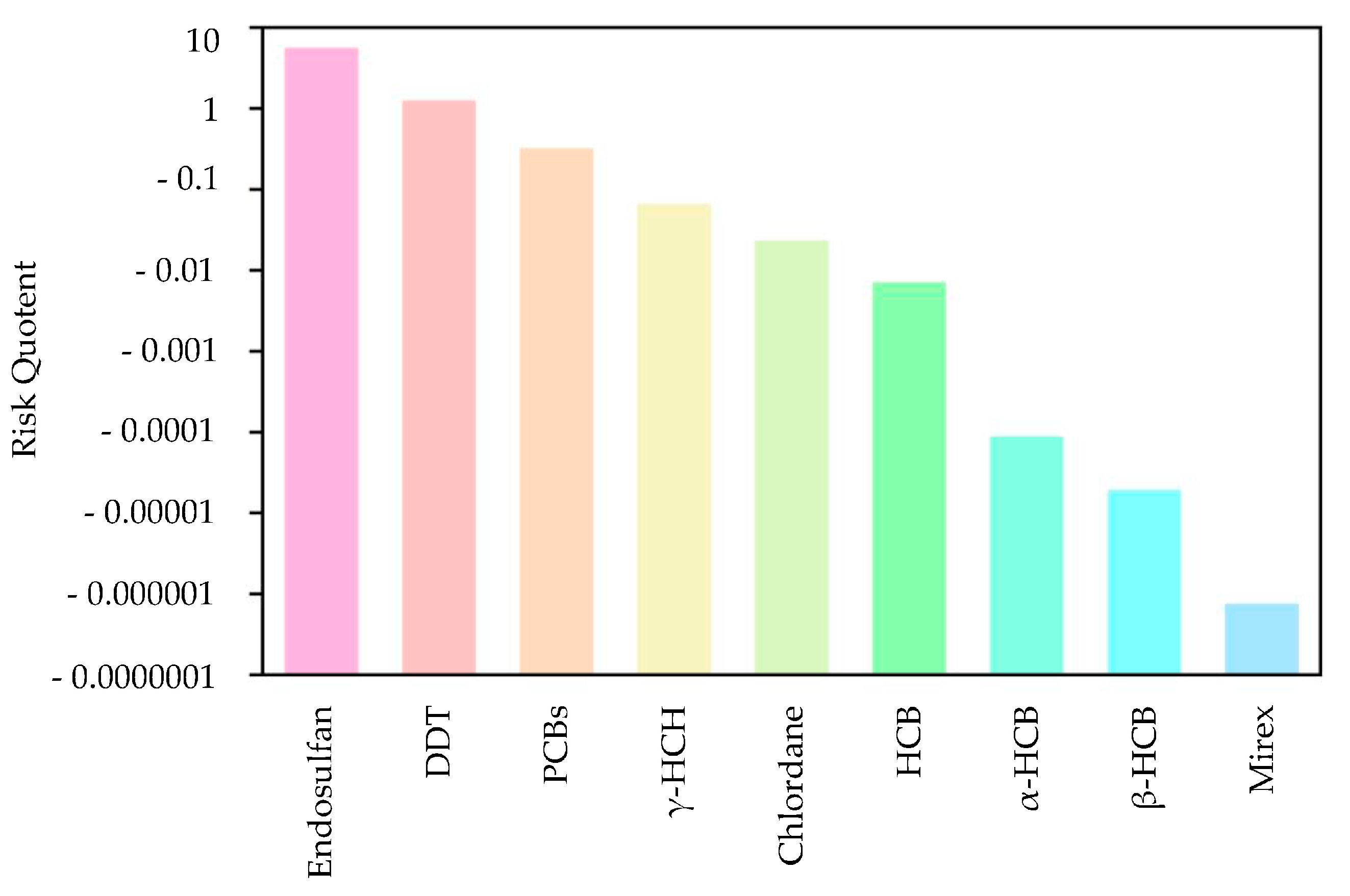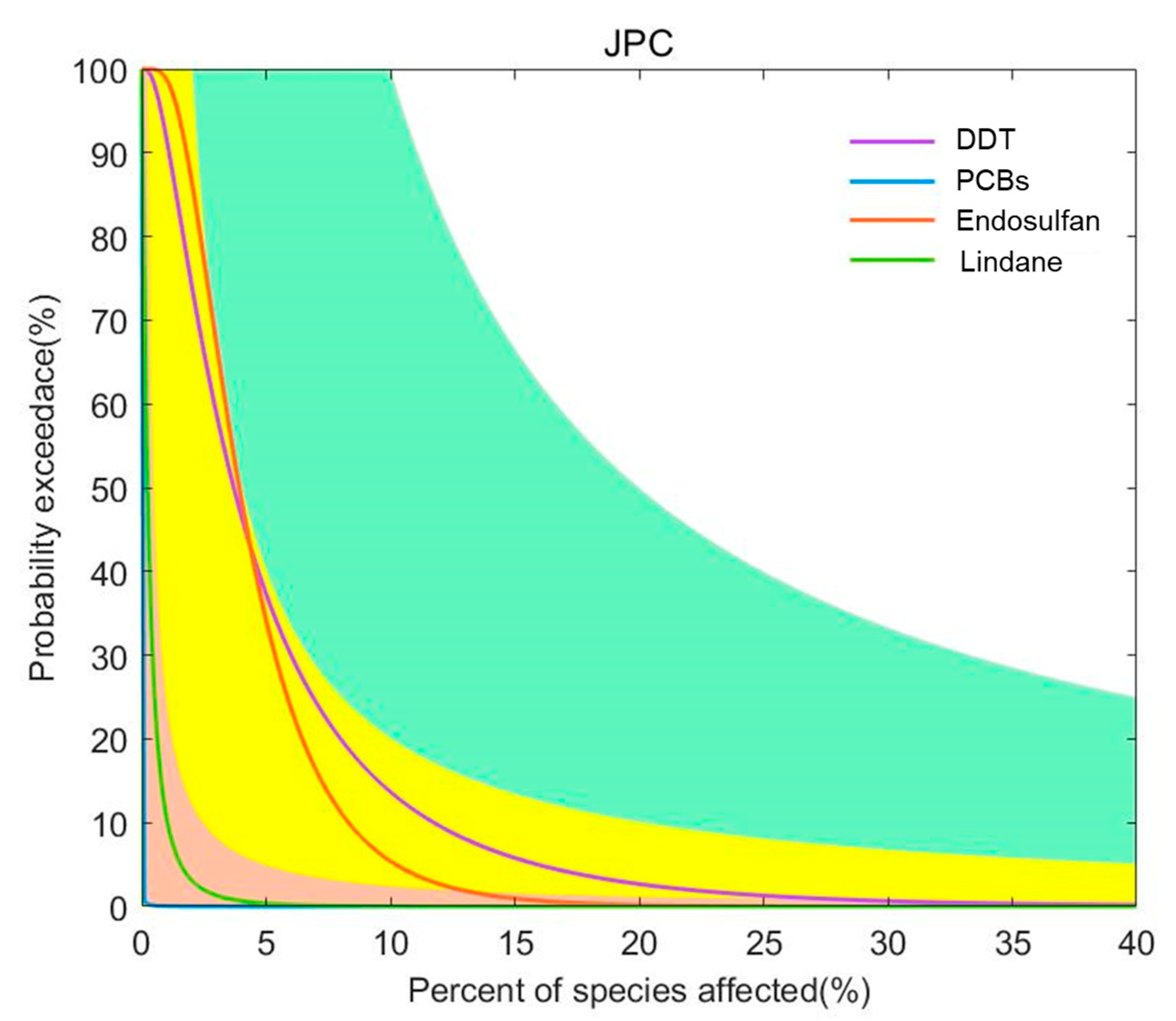Ecological Risk Assessment of Organochlorine Pesticides and Polychlorinated Biphenyls in Coastal Sediments in China
Abstract
1. Introduction
2. Materials and Methods
2.1. Evaluation and Selection of Data
2.1.1. Environmental Concentration Data of Pollutants
2.1.2. Environmental Toxicity Information
2.2. Derivation of Sediment Quality Benchmarks Using the Phase Equilibrium Distribution Method
2.3. Ecological Risk Assessment
2.3.1. First Level: Quotient Value Method
2.3.2. Second Level: Semi-Probability Method
2.3.3. Third Level: Semi-Probability Method for Optimization
2.3.4. Fourth Level: Joint Probability Curves
3. Results and Discussion
3.1. Distribution of Pesticides in China’s Coastal Sediments
3.2. Toxic Effects of Pesticide Pollutants
3.3. Risk Characterizations
3.3.1. First Level: Quotient Value Method
3.3.2. Second Level: Semi-Probability Method
3.3.3. Third Level: Semi-Probability Method for Optimization
3.3.4. Joint Probability Curve Method
3.3.5. Comparing the Risk Assessment Results Generated Using the Four Methods
4. Conclusions
- (1)
- Nine kinds of pesticide pollutants are widespread in China’s coastal sediments, with concentrations ranging from 0.01 ng·L−1 to 330 ng·L−1.
- (2)
- The first-level quotient method assessment showed that the risk quotients of the nine chlorinated hydrocarbon pollutants were ranked in descending order as endosulfan, DDT, PCBs, lindane, chlordane, HCB, α-HCH, β-HCH, and mirex. Among these pollutants, endosulfan and DDT posed a medium environmental risk to the sediments in the coastal waters of China, and PCBs posed a medium risk in some bays of the East China Sea. The second-level semi-probability assessment showed that endosulfan, DDT, lindane, and PCBs should be considered as priority pollutants. The semi-probability evaluation results of the third-level optimization show that the focus should be on the ecological risks of endosulfan, DDT, PCBs, and lindane in China’s coastal sediments, especially endosulfan and DDT. The four-level joint probability curve method assessment shows that endosulfan and DDT have a low risk of chronic effects on aquatic organisms.
- (3)
- Based on the four evaluation methods, this study concludes that endosulfan and DDT pose environmental risks to China’s coastal sediments.
Author Contributions
Funding
Data Availability Statement
Conflicts of Interest
References
- Brain, R.A.; Ramirez, A.J.; Fulton, B.A.; Chambliss, C.K.; Brooks, B.W. Herbicidal effects of sulfamethoxazole in Lemna gibba: Using p-aminobenzoic acid as a biomarker of effect. Environ. Sci. Technol. 2008, 42, 8965–8970. [Google Scholar] [CrossRef] [PubMed]
- Li, M.-R.; Men, S.-H.; Wang, Z.-Y.; Liu, C.; Zhou, G.-R.; Yan, Z.-G. The application of human-derived cell lines in neurotoxicity studies of environmental pollutants. Sci. Total Environ. 2024, 912, 168839. [Google Scholar] [CrossRef] [PubMed]
- Xu, J.-Y.; Wang, K.; Men, S.-H.; Yang, Y.; Zhou, Q.; Yan, Z.-G. QSAR-QSIIR-based prediction of bioconcentration factor using machine learning and preliminary application. Environ. Int. 2023, 177, 108003. [Google Scholar] [CrossRef] [PubMed]
- Daughton, C.G.; Ternes, T.A. Pharmaceuticals and personal care products in the environment: Agents of subtle change? Environ. Health Perspect. 1999, 107, 907–938. [Google Scholar] [CrossRef] [PubMed]
- Peck, A.M. Analytical methods for the determination of persistent ingredients of personal care products in environmental matrices. Anal. Bioanal. Chem. 2006, 386, 907–939. [Google Scholar] [CrossRef] [PubMed]
- Yang, G.; Fan, M.; Zhang, G. Emerging contaminants in surface waters in China—A short review. Environ. Res. Lett. 2014, 9, 074018. [Google Scholar] [CrossRef]
- Qian, M.-M.; Wang, Z.-Y.; Zhou, Q.; Wang, J.; Shao, Y.; Qiao, Q.; Fan, J.-T.; Yan, Z.-G. Environmental DNA unveiling the fish community structure and diversity features in the Yangtze River basin. Environ. Res. 2023, 239, 117198. [Google Scholar] [CrossRef]
- Lan, J.; Jia, J.; Liu, A.; Yu, Z.; Zhao, Z. Pollution levels of banned and non-banned pesticides in surface sediments from the East China Sea. Mar. Pollut. Bull. 2019, 139, 332–338. [Google Scholar] [CrossRef]
- Li, W.; Yang, H.; Gao, Q.; Pan, H.; Yang, H. Residues of organochlorine pesticides in water and suspended particulate matter from Xiangshan Bay, East China Sea. Bull. Environ. Contam. Toxicol. 2012, 89, 811–815. [Google Scholar] [CrossRef]
- Peris, A.; Barbieri, M.V.; Postigo, C.; Rambla-Alegre, M.; Lopez de Alda, M.; Eljarrat, E. Pesticides in sediments of the Ebro River Delta cultivated area (NE Spain): Occurrence and risk assessment for aquatic organisms. Environ. Pollut. 2022, 305, 119239. [Google Scholar] [CrossRef]
- Singare, P.U. Persistent organic pesticide residues in sediments of Vasai Creek near Mumbai: Assessment of sources and potential ecological risk. Mar. Pollut. Bull. 2015, 100, 464–475. [Google Scholar] [CrossRef] [PubMed]
- Buah-Kwofie, A.; Humphries, M.S. The distribution of organochlorine pesticides in sediments from iSimangaliso Wetland Park: Ecological risks and implications for conservation in a biodiversity hotspot. Environ. Pollut. 2017, 229, 715–723. [Google Scholar] [CrossRef] [PubMed]
- Sarkar, A.; Nagarajan, R.; Chaphadkar, S.; Pal, S.; Singbal, S.Y.S. Contamination of organochlorine pesticides in sediments from the Arabian Sea along the west coast of India. Water Res. 1997, 31, 195–200. [Google Scholar] [CrossRef]
- Shi, J.; Li, P.; Li, Y.; Liu, W.; Zheng, G.J.; Xiang, L.; Huang, Z. Polychlorinated biphenyls and organochlorine pesticides in surface sediments from Shantou Bay, China: Sources, seasonal variations and inventories. Mar. Pollut. Bull. 2016, 113, 585–591. [Google Scholar] [CrossRef] [PubMed]
- Hu, W.; Wang, T.; Khim, J.S.; Luo, W.; Jiao, W.; Lu, Y.; Naile, J.E.; Chen, C.; Zhang, X.; Giesy, J.P. HCH and DDT in Sediments from Marine and Adjacent Riverine Areas of North Bohai Sea, China. Arch. Environ. Contam. Toxicol. 2010, 59, 71–79. [Google Scholar] [CrossRef] [PubMed]
- Zhou, S.-S.; Shao, L.-Y.; Yang, H.-Y.; Wang, C.; Liu, W.-P. Residues and sources recognition of polychlorinated biphenyls in surface sediments of Jiaojiang Estuary, East China Sea. Mar. Pollut. Bull. 2012, 64, 539–545. [Google Scholar] [CrossRef] [PubMed]
- Guo, G.; Wu, F.; He, H.; Zhang, R.; Li, H. Ecological Risk Assessment of Organochlorine Pesticides in Surface Waters of Lake Taihu, China. Hum. Ecol. Risk Assess. 2012, 19, 840–856. [Google Scholar] [CrossRef]
- Xu, M.; Huang, H.; Li, N.; Li, F.; Wang, D.; Luo, Q. Occurrence and ecological risk of pharmaceuticals and personal care products (PPCPs) and pesticides in typical surface watersheds, China. Ecotoxicol. Environ. Saf. 2019, 175, 289–298. [Google Scholar] [CrossRef]
- Zhang, H.; Shan, B. Historical distribution of DDT residues in pond sediments in an intensive agricultural watershed in the Yangtze-Huaihe region, China. J. Soils Sediments 2014, 14, 980–990. [Google Scholar] [CrossRef]
- Tang, D.; Liu, X.; He, H.; Cui, Z.; Gan, H.; Xia, Z. Distribution, sources and ecological risks of organochlorine compounds (DDTs, HCHs and PCBs) in surface sediments from the Pearl River Estuary, China. Mar. Pollut. Bull. 2020, 152, 110942. [Google Scholar] [CrossRef]
- Zhao, L.; Hou, H.; Zhou, Y.; Xue, N.; Li, H.; Li, F. Distribution and ecological risk of polychlorinated biphenyls and organochlorine pesticides in surficial sediments from Haihe River and Haihe Estuary Area, China. Chemosphere 2010, 78, 1285–1293. [Google Scholar] [CrossRef]
- Xie, H.; Wang, X.; Chen, J.; Li, X.; Jia, G.; Zou, Y.; Zhang, Y.; Cui, Y. Occurrence, distribution and ecological risks of antibiotics and pesticides in coastal waters around Liaodong Peninsula, China. Sci. Total. Environ. 2019, 656, 946–951. [Google Scholar] [CrossRef] [PubMed]
- Wang, X.; Zhang, Z.; Zhang, R.; Huang, W.; Dou, W.; You, J.; Jiao, H.; Sun, A.; Chen, J.; Shi, X.; et al. Occurrence, source, and ecological risk assessment of organochlorine pesticides and polychlorinated biphenyls in the water-sediment system of Hangzhou Bay and East China Sea. Mar. Pollut. Bull. 2022, 179, 113735. [Google Scholar] [CrossRef] [PubMed]
- Sultan, M.; Hamid, N.; Junaid, M.; Duan, J.J.; Pei, D.S. Organochlorine pesticides (OCPs) in freshwater resources of Pakistan: A review on occurrence, spatial distribution and associated human health and ecological risk assessment. Ecotoxicol. Environ. Saf. 2023, 249, 114362. [Google Scholar] [CrossRef] [PubMed]
- U.S. EPA. Evaluation Guidelines for Ecological Toxicity Data in the Open Literature; Environmental Fate and Effects Division, Office of Pesticide Programs: Washington, DC, USA, 2011. [Google Scholar]
- Klimisch, H.J.; Andreae, M.; Tillmann, U. A systematic approach for evaluating the quality of experimental toxicological and ecotoxicological data. Regul. Toxicol. Pharmacol. 1997, 25, 1–5. [Google Scholar] [CrossRef] [PubMed]
- Durda, J.L.; Preziosi, D.V. Data Quality Evaluation of Toxicological Studies Used to Derive Ecotoxicological Benchmarks. Hum. Ecol. Risk Assess. 2000, 6, 747–765. [Google Scholar] [CrossRef]
- Hobbs, D.A.; Warne, M.S.; Markich, S.J. Evaluation of criteria used to assess the quality of aquatic toxicity data. Integr. Environ. Assess. Manag. 2005, 1, 174–180. [Google Scholar] [CrossRef] [PubMed]
- Moermond, C.T.; Kase, R.; Korkaric, M.; Agerstrand, M. CRED: Criteria for reporting and evaluating ecotoxicity data. Environ. Toxicol. Chem. 2016, 35, 1297–1309. [Google Scholar] [CrossRef] [PubMed]
- Bu, Q.; Wang, B.; Huang, J.; Deng, S.; Yu, G. Pharmaceuticals and personal care products in the aquatic environment in China: A review. J. Hazard. Mater. 2013, 262, 189–211. [Google Scholar] [CrossRef]
- Adams, W.J.; Kimerle, R.A.; Barnett, J.W. Sediment quality and aquatic life assessment. Environ. Sci. Tech. 2002, 26, 1864–1875. [Google Scholar] [CrossRef]
- European Commission. Technical Guidance Document on Risk Assessment; Joint Research Centre, Institute for Health and Consumer Protection, European Chemicals Bureau: Ispra, Italy, 2003. [Google Scholar]
- U.S. EPA. Guidelines for Ecological Risk Assessment; United States Environmental Protection Agency: Washington, DC, USA, 1998. [Google Scholar]
- U.S. EPA. Framework for Ecotoxicological Risk Assessment; United States Environmental Protection Agency: Washington, DC, USA, 1992. [Google Scholar]
- Zhou, S.-X.; Li, X.-F. Interfacial debonding of an orthotropic half-plane bonded to a rigid foundation. Int. J. Solids Struct. 2019, 161, 1–10. [Google Scholar] [CrossRef]
- Desbiolles, F.; Malleret, L.; Tiliacos, C.; Wong-Wah-Chung, P.; Laffont-Schwob, I. Occurrence and ecotoxicological assessment of pharmaceuticals: Is there a risk for the Mediterranean aquatic environment? Sci. Total. Environ. 2018, 639, 1334–1348. [Google Scholar] [CrossRef] [PubMed]
- Liu, N.; Jin, X.; Feng, C.; Wang, Z.; Wu, F.; Johnson, A.C.; Xiao, H.; Hollert, H.; Giesy, J.P. Ecological risk assessment of fifty pharmaceuticals and personal care products (PPCPs) in Chinese surface waters: A proposed multiple-level system. Environ. Int. 2020, 136, 105454. [Google Scholar] [CrossRef] [PubMed]
- Tarazona, J.V.; Escher, B.I.; Giltrow, E.; Sumpter, J.; Knacker, T. Targeting the environmental risk assessment of pharmaceuticals: Facts and fantasies. Integr. Environ. Assess. Manag. 2010, 6, 603–613. [Google Scholar] [CrossRef] [PubMed]
- Ågerstrand, M.; Rudén, C. Evaluation of the accuracy and consistency of the Swedish Environmental Classification and Information System for pharmaceuticals. Environ. Sci. Technol. 2010, 408, 2327–2339. [Google Scholar] [CrossRef] [PubMed]
- von der Ohe, P.C.; Dulio, V.; Slobodnik, J.; De Deckere, E.; Kühne, R.; Ebert, R.U.; Ginebreda, A.; De Cooman, W.; Schüürmann, G.; Brack, W. A new risk assessment approach for the prioritization of 500 classical and emerging organic microcontaminants as potential river basin specific pollutants under the European Water Framework Directive. Environ. Sci. Technol. 2011, 409, 2064–2077. [Google Scholar] [CrossRef] [PubMed]
- Zhou, S.; Di Paolo, C.; Wu, X.; Shao, Y.; Seiler, T.B.; Hollert, H. Optimization of screening-level risk assessment and priority selection of emerging pollutants—The case of pharmaceuticals in European surface waters. Environ. Int. 2019, 128, 1–10. [Google Scholar] [CrossRef]
- Tousova, Z.; Oswald, P.; Slobodnik, J.; Blaha, L.; Muz, M.; Hu, M.; Brack, W.; Krauss, M.; Di Paolo, C.; Tarcai, Z.; et al. European demonstration program on the effect-based and chemical identification and monitoring of organic pollutants in European surface waters. Sci. Total. Environ. 2017, 601–602, 1849–1868. [Google Scholar] [CrossRef]
- von der Ohe, P.C.; Dulio, V. NORMAN Prioritisation Framework for Emerging Substances; NORMAN Association: Verneuil-en-Halatte, France, 2013. [Google Scholar]
- Moore, D.R.; Thompson, R.P.; Rodney, S.I.; Fischer, D.; Ramanarayanan, T.; Hall, T. Refined aquatic risk assessment for aldicarb in the United States. Integr. Environ. Assess. Manag. 2010, 6, 102–118. [Google Scholar] [CrossRef]
- Moore, D.R.; Teed, R.S.; Greer, C.D.; Solomon, K.R.; Giesy, J.P. Refined avian risk assessment for chlorpyrifos in the United States. Rev. Environ. Contam. Toxicol. 2014, 231, 163–217. [Google Scholar]
- Whitfield Aslund, M.; Breton, R.L.; Padilla, L.; Winchell, M.; Wooding, K.L.; Moore, D.R.; Teed, R.S.; Reiss, R.; Whatling, P. Ecological risk assessment for Pacific salmon exposed to dimethoate in California. Environ. Toxicol. Chem. 2017, 36, 532–543. [Google Scholar] [CrossRef]
- Clemow, Y.H.; Manning, G.E.; Breton, R.L.; Winchell, M.F.; Padilla, L.; Rodney, S.I.; Hanzas, J.P.; Estes, T.L.; Budreski, K.; Toth, B.N.; et al. A refined ecological risk assessment for California red-legged frog, Delta smelt, and California tiger salamander exposed to malathion. Integr. Environ. Assess. Manag. 2018, 14, 224–239. [Google Scholar] [CrossRef]







| Chemicals | Endpoint | Concentration (ng·L−1) | AF | WQC | PNECsediment |
|---|---|---|---|---|---|
| DDT | NOEC | 5 | 10 | 0.5 | 4.9 |
| β-HCH | NOEC | 32,000 | 10 | 3200 | 27,646 |
| HCB | NOEC | 96.6 | 10 | 9.66 | 193 |
| α-HCH | EC50 | 65,000 | 100 | 650 | 5616 |
| Lindane | NOEC | 10 | 10 | 1 | 8.6 |
| Endosulfan | NOEC | 0.1 | 10 | 0.01 | 0.03 |
| Chlordane | LOEC | 1 | 20 | 0.05 | 27.5 |
| PCBs | LOEC | 15 | 20 | 0.75 | 58.5 |
| Mirex | EC50 | 12,000 | 100 | 120 | 841,820 |
Disclaimer/Publisher’s Note: The statements, opinions and data contained in all publications are solely those of the individual author(s) and contributor(s) and not of MDPI and/or the editor(s). MDPI and/or the editor(s) disclaim responsibility for any injury to people or property resulting from any ideas, methods, instructions or products referred to in the content. |
© 2024 by the authors. Licensee MDPI, Basel, Switzerland. This article is an open access article distributed under the terms and conditions of the Creative Commons Attribution (CC BY) license (https://creativecommons.org/licenses/by/4.0/).
Share and Cite
Wang, J.; Zhao, Q.; Gao, F.; Wang, Z.; Li, M.; Li, H.; Wang, Y. Ecological Risk Assessment of Organochlorine Pesticides and Polychlorinated Biphenyls in Coastal Sediments in China. Toxics 2024, 12, 114. https://doi.org/10.3390/toxics12020114
Wang J, Zhao Q, Gao F, Wang Z, Li M, Li H, Wang Y. Ecological Risk Assessment of Organochlorine Pesticides and Polychlorinated Biphenyls in Coastal Sediments in China. Toxics. 2024; 12(2):114. https://doi.org/10.3390/toxics12020114
Chicago/Turabian StyleWang, Jie, Qi Zhao, Fu Gao, Ziye Wang, Mingrui Li, Haiming Li, and Yizhe Wang. 2024. "Ecological Risk Assessment of Organochlorine Pesticides and Polychlorinated Biphenyls in Coastal Sediments in China" Toxics 12, no. 2: 114. https://doi.org/10.3390/toxics12020114
APA StyleWang, J., Zhao, Q., Gao, F., Wang, Z., Li, M., Li, H., & Wang, Y. (2024). Ecological Risk Assessment of Organochlorine Pesticides and Polychlorinated Biphenyls in Coastal Sediments in China. Toxics, 12(2), 114. https://doi.org/10.3390/toxics12020114





